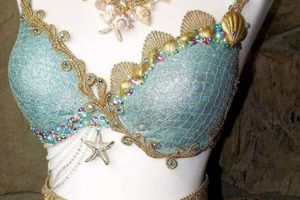A self-assembled religious habit, often created for costume parties or theatrical productions, replicates the traditional attire of a female member of a religious order. Examples of such handcrafted ensembles range from simple modifications of existing black clothing to elaborate recreations utilizing sewing skills and readily available fabrics.
The appeal of constructing such an outfit lies in its affordability and the opportunity for personalization. Historical context reveals that religious habits have varied significantly across different orders and time periods, influencing the stylistic choices made in these homemade versions. The garments communicate religious adherence and symbolize ideals of poverty, simplicity, and devotion, aspects that inform the design choices whether used respectfully or satirically.
The subsequent sections will explore essential components, material selection, and ethical considerations when crafting a faithful or stylized interpretation of this iconic garment.
Assembly Guidance
This section provides guidance on constructing a homemade religious habit, focusing on accuracy, respect, and practicality for costume or theatrical purposes. Considerations for material selection, pattern drafting, and ethical implications are addressed.
Tip 1: Research Authentic Garment Styles: Before commencing, thoroughly research the specific order the representation intends to portray. Different orders have unique styles, including variations in veiling, scapular length, and overall silhouette. Consult historical references or online resources for visual accuracy.
Tip 2: Prioritize Modest Fabric Selection: Opt for matte, opaque fabrics such as broadcloth, poplin, or linen. Avoid shiny or revealing materials. Dark colors like black, navy, or dark brown are traditional, though some orders utilize gray or white.
Tip 3: Pattern Adaptation or Creation: Utilize existing patterns for simple dresses or tunics as a base. Adapt these patterns to create the required wide sleeves and floor-length cut. For the veil, draft a simple rectangular pattern, adjusting dimensions according to the desired style.
Tip 4: Construct a Supportive Headpiece: The wimple, or guimpe, requires a firm yet comfortable base. Use buckram or heavy interfacing to provide structure. Ensure the headpiece securely holds the veil in place without causing discomfort.
Tip 5: Emphasize Accuracy over Exaggeration: Avoid overly theatrical embellishments or caricatures. The focus should be on replicating the essential elements of the habit respectfully, rather than creating a comedic or sensationalized version.
Tip 6: Layering for Authenticity: A complete habit often involves multiple layers, including an underdress, a scapular, and a belt or cord. Account for these layers in the design and construction process to achieve a more authentic appearance.
Tip 7: Consider Practicality and Comfort: For extended wear, prioritize comfort. Choose breathable fabrics and ensure adequate ease of movement. Account for potential heat buildup under multiple layers of fabric.
Successful creation involves meticulous attention to detail and respect for the religious significance of the garments. Adhering to these guidelines increases the likelihood of a well-executed and authentic-looking outcome.
The subsequent section will address potential challenges and offer solutions for common construction difficulties, as well as discuss the responsible use of the finished representation.
1. Authenticity
Authenticity, in the context of a self-constructed religious habit, refers to the degree to which the costume accurately reflects the attire of a specific religious order. This accuracy extends beyond mere visual similarity, encompassing details of cut, fabric, and symbolic elements. The pursuit of authenticity affects the level of research and craftsmanship required.
- Order-Specific Research
Achieving authenticity necessitates thorough research into the habits worn by different orders. Variations exist in color, style, and the presence or absence of specific components like rosaries or crucifixes. For instance, a Benedictine habit differs significantly from that of a Carmelite. Accurate representation demands detailed study of available visual and textual resources relating to the order being portrayed.
- Fabric and Material Accuracy
The choice of fabric is crucial. Certain orders historically used specific materials like wool or linen. Replicating the texture and drape of these fabrics contributes significantly to the garment’s overall authenticity. Modern substitutions may be necessary for practicality or cost, but should be selected to closely mimic the original material’s appearance.
- Construction Techniques
Authentic religious habits were often constructed using specific sewing techniques. While replicating hand-sewing is not always feasible, understanding the original construction methods can inform design choices. Attention to seam placement, pleating, and other construction details elevates the accuracy of the representation.
- Symbolic Details and Accessories
Many habits incorporate symbolic accessories, such as specific types of belts, rosaries, or crosses. Accurately representing these details enhances the overall authenticity. The placement and style of these items often carry specific meaning within the order and should be carefully considered.
The quest for authenticity in a replicated religious habit involves balancing historical accuracy with practical considerations. While a perfect recreation may not always be attainable, diligent research and attention to detail significantly improve the garment’s representation and demonstrate respect for the traditions it seeks to emulate.
2. Simplicity
Simplicity is intrinsically linked to crafting a religious habit replica. The historical context of religious orders often includes vows of poverty and a rejection of worldly extravagance, directly influencing the design and construction of their attire. A self-made version, therefore, benefits from an emphasis on simple construction techniques and readily available materials, mirroring the original intent. Overly elaborate designs or expensive fabrics contradict the symbolic meaning associated with the garment. Practical examples include utilizing basic sewing skills to assemble a floor-length tunic from unadorned cotton or linen, eschewing complex patterns and embellishments. Understanding this principle guides the creator toward an authentic and respectful outcome.
Further illustrating the practical application of simplicity is the construction process itself. A straightforward pattern design minimizes waste and reduces the time investment required. For example, a rectangular veil avoids intricate shaping,
and a simple cord replaces an elaborate belt. These decisions streamline the creation process without compromising the essential visual characteristics. From a functional perspective, prioritizing simplicity contributes to the costume’s wearability, ensuring comfort and ease of movement.
In summary, simplicity is not merely an aesthetic choice but a fundamental principle in creating an appropriate replica. By embracing this value in both design and execution, challenges associated with complex construction are mitigated, and the resulting garment more accurately reflects the historical and spiritual significance inherent in religious attire. This understanding enhances the project and aligns with respectful representation.
3. Modesty
Modesty holds paramount importance in the creation of a religious habit replica. As a core tenet within many religious orders, modesty dictates both the design and the intended use of the garment. The purpose of a religious habit is not to attract attention or elicit admiration, but to signify a commitment to a life of prayer, service, and detachment from worldly concerns. Disregarding this principle in a homemade version risks undermining the very essence of the attire it seeks to represent. For instance, using sheer or form-fitting fabrics would fundamentally contradict the symbolic intention. Therefore, understanding and upholding modesty is an essential factor in successfully constructing a respectful and authentic representation.
Practical implications of upholding modesty are evident in material selection, silhouette, and detailing. High necklines, long sleeves, and floor-length hems are standard design elements that adhere to this principle. The choice of fabric is equally crucial; opaque materials in dark or neutral colors are preferred to avoid drawing undue attention. Furthermore, embellishments are typically kept to a minimum or entirely absent. A real-world example could be seen in contrasting two versions: one crafted from shimmering silk with a short hemline, and another made from matte wool with a traditional cut. The latter more faithfully embodies the concept of modesty and, consequently, presents a more accurate portrayal.
In conclusion, the successful creation of a religious habit replication fundamentally depends on respecting and integrating the principle of modesty. It is not simply an aesthetic consideration but a guiding force that shapes every aspect of the design and construction process. Any deviation from this principle risks misrepresenting the values and intentions inherent in the original garment, resulting in a costume that fails to capture the true essence of religious attire.
4. Material Choice
Selecting suitable materials is paramount in crafting a religious habit replica. The fabrics used dictate the garment’s appearance, durability, and overall authenticity. Careful consideration of material properties is essential to achieve a respectful and accurate representation.
- Fabric Weight and Drape
The weight of the fabric significantly influences the garment’s drape and silhouette. Heavier fabrics, such as wool broadcloth, create a more structured and formal appearance, whereas lighter fabrics, like linen, result in a softer, more flowing drape. For example, a habit intended to replicate that of a monastic order might benefit from a heavier fabric to convey the somber nature associated with this type of garment. A habit replicating one worn in warmer climates might utilize a lighter, more breathable fabric.
- Color and Texture
Color and texture play crucial roles in visual accuracy. Traditionally, habits are crafted from dark, matte fabrics like black, brown, or navy. While variations exist across different orders, the overall aim is to avoid bright or ostentatious colors. The texture of the fabric also contributes to the overall effect. For instance, a rough-textured wool can evoke a sense of austerity, while a smooth cotton provides a more polished appearance. The choice should align with the specific aesthetic of the intended order.
- Durability and Maintenance
The durability of the selected material is a practical consideration, particularly if the habit is intended for frequent use. Fabrics such as polyester blends offer increased resistance to wear and tear, and may require less maintenance than natural fibers. However, these materials may lack the authentic look and feel of traditional fabrics. Balancing durability with visual accuracy is a key consideration in material selection. For example, a costume used for theatrical productions may benefit from more durable synthetic materials.
- Cost and Availability
Budgetary constraints and material availability often influence the final selection. While authentic fabrics may be desirable, they are not always accessible or affordable. Practical alternatives that closely resemble the desired appearance are often necessary. The cost of materials must be balanced against the overall project budget and the desired level of authenticity. For instance, readily available cotton blends can serve as a cost-effective substitute for more expensive linen or wool.
In summary, mindful material selection is essential in achieving a successful and respectful replica of religious attire. Weight, color, durability, and cost are all key considerations that influence the final outcome. Careful evaluation of these factors ensures the completed project accurately represents the intended style and symbolism.
5. Veil Structure
The veil structure forms a critical component of a self-constructed religious habit. Its design and construction contribute significantly to the overall visual accuracy and authenticity of the costume, impacting its perceived adherence to established religious attire. The veil’s shape, size, and method of attachment are integral to conveying a specific religious order’s representation.
- Veil Shape and Dimensions
The shape and dimensions of the veil vary significantly across different religious orders. Some orders utilize simple rectangular veils, while others employ more complex, contoured shapes. The length and width of the veil also differ, influencing the amount of coverage provided. Accurately replicating the veil’s shape and dimensions is vital for achieving an authentic representation. For example, a long, flowing veil is characteristic of some Carmelite orders, while a shorter, more structured veil is typical of certain Benedictine orders. Discrepancies in shape and dimension can detract from the overall accuracy.
- Attachment Method and Head Covering
The method of attaching the veil to the head, along with the style of head covering worn beneath, also differs across orders. Some veils are pinned directly to the hair or a simple cap, while others are secured to a more elaborate headpiece, such as a wimple or guimpe. The choice of attachment method affects the veil’s stability and the overall silhouette of the costume. For instance, a wimple provides a structured base for the veil, creating a distinct visual effect. The choice of head covering should accurately reflect the specific order be
ing represented. - Fabric and Layering
The fabric used for the veil, as well as the number of layers, contributes to its opacity, drape, and overall appearance. Lightweight, semi-transparent fabrics may be used in multiple layers to achieve the desired level of coverage. Heavier, opaque fabrics may be used in a single layer. The color of the fabric is typically black or white, although some orders utilize other colors. For example, a novice may wear a white veil before professing final vows and receiving a black veil. The selection of fabric and layering should accurately reflect the traditions of the specific order being represented.
- Structural Support
Some veil styles incorporate structural support to maintain their shape and prevent them from collapsing. This support may be provided by wire, buckram, or other stiff materials. The type and amount of support required depends on the design of the veil. For example, a tall, conical veil may require significant internal support to maintain its shape. The use of appropriate structural support is essential for achieving the desired visual effect.
These elements of veil structure are all fundamental in the design and execution of a replicated religious habit. Each choice impacts the costume’s perceived authenticity and its success in respectfully portraying a specific religious order. Attention to detail in these areas elevates the final product beyond a simple costume, creating a more accurate and meaningful representation.
6. Scapular Design
The scapular constitutes a significant element within many religious orders’ habits and is, therefore, a key consideration when constructing a representation of such attire. Its design, encompassing dimensions, color, and method of attachment, directly impacts the overall accuracy and visual integrity of a self-assembled habit. The absence of a properly designed scapular, or the inclusion of an inaccurate one, can diminish the authenticity of the entire representation.
The influence of scapular design on the overall aesthetic of a handcrafted religious habit stems from its prominent placement and symbolic value. For example, Benedictine scapulars are typically long, covering much of the habit, while Carmelite scapulars are significantly smaller. Ignoring these distinctions results in a garment that fails to accurately represent a specific order. The practical application of this understanding involves meticulous research into the appropriate design for the intended order and careful attention to detail during construction.
Ultimately, a thorough understanding of scapular design is essential for those undertaking the creation of a homemade religious habit. Accurately replicating the scapular’s dimensions, color, and attachment method not only enhances the aesthetic realism of the project but also demonstrates respect for the traditions and symbolism inherent in religious attire. Challenges in accurate replication can be overcome with careful research and attention to detail, ensuring the representation aligns closely with the visual norms of the order being depicted.
7. Ethical Implications
The construction and use of a self-assembled religious habit raises several ethical considerations. These considerations extend beyond simple costume creation and touch upon issues of cultural sensitivity, respect for religious traditions, and the potential for misrepresentation or mockery. A responsible approach requires careful reflection on the potential impact of such a project.
- Cultural Appropriation and Respect
The unauthorized adoption of elements from a religious culture, particularly when used for entertainment or personal gain, can be construed as cultural appropriation. A self-made religious habit risks trivializing deeply held beliefs and practices. The line between respectful representation and insensitive mockery can be blurred, requiring careful attention to intent and execution. For instance, a costume worn at a Halloween party that exaggerates or satirizes religious attributes crosses an ethical boundary. The key is understanding and respecting the symbolic meaning of the attire within its original cultural context.
- Misrepresentation and Deception
Wearing a religious habit replica with the intent to deceive or misrepresent oneself presents a significant ethical concern. Such actions can damage the reputation of religious orders and create false impressions. For example, fraudulently soliciting donations while dressed as a religious figure constitutes a clear ethical violation. The potential for abuse necessitates careful consideration of the intended purpose and audience.
- Satire and Parody Considerations
While satire and parody may be forms of artistic expression, they must be approached with caution when dealing with religious symbols. Overly critical or disrespectful portrayals can be deeply offensive to religious communities. The ethical dilemma lies in balancing freedom of expression with the need to avoid causing undue harm or offense. For example, a satirical performance that ridicules religious beliefs through the use of a habit risks alienating and offending members of that faith.
- Commercial Exploitation
The commercialization of religious attire can also raise ethical concerns. Selling mass-produced, low-quality religious habits as novelty items trivializes the meaning and purpose of the garment. Profit-driven motives, especially when insensitive to religious values, present an ethical conflict. A more responsible approach involves understanding the history and significance of the habit and ensuring that its reproduction is done with respect and sensitivity.
These facets highlight the importance of responsible creation and utilization when replicating religious attire. Thoughtful consideration of cultural impact, potential for misrepresentation, the nuances of satire, and the dangers of commercial exploitation are essential to ensure that the DIY religious habit is handled with the respect and sensitivity it warrants. Ignoring these ethical considerations risks causing offense and perpetuating harmful stereotypes.
Frequently Asked Questions
The following questions address common inquiries and concerns regarding the creation and use of a self-assembled representation of a religious habit. The responses aim to provide clarity and guidance for a respectful and informed approach.
Question 1: Is it inherently disrespectful to construct a replica of a religious habit?
Not necessarily. Disrespect arises from the intent and use of the replica. If the intention is to mock, denigrate, or misrepresent the religious order, then the action is disrespectful. However, if the intention is educational, theatrical, or part of a respectful historical portrayal, it may not be inherently disrespectful, provided sensitivity and accuracy are prioritized.
Question 2: What resources are available for researching authentic habit styles?
Numerous resources exist, including historical texts, museum collections, religious order websites, and academic articles. Visual resources, such as paintings and photographs, can provide detailed information about fabric, cut, and accessories. Consulting with members of the relevant religious order, where pos
sible, can offer invaluable insights.
Question 3: What are the most common mistakes to avoid when creating a replica?
Common mistakes include using inappropriate fabrics (e.g., shiny or revealing materials), inaccurately representing the cut or dimensions of the garment, neglecting essential accessories (e.g., rosaries or crucifixes), and failing to research the specific order being portrayed. Attention to detail and a commitment to authenticity are crucial.
Question 4: How can one ensure the costume is not perceived as mockery or caricature?
Avoid exaggeration or distortion of the garment’s features. Refrain from incorporating comedic elements or satirical embellishments. Maintain a respectful demeanor when wearing the costume, and avoid using it in contexts that could be considered offensive or disrespectful. Context and intent are critical in mitigating the risk of misinterpretation.
Question 5: What are the legal implications, if any, of wearing a religious habit replica?
Legal implications are generally minimal unless the garment is used to impersonate a member of a religious order for fraudulent purposes, such as soliciting donations under false pretenses. Laws regarding impersonation and fraud vary by jurisdiction, so it’s crucial to understand local regulations.
Question 6: Is it appropriate to wear a religious habit replica for Halloween or costume parties?
The appropriateness depends on the individual’s intent and the context of the event. If the intention is to respectfully portray a religious figure or order, and the event is not inherently disrespectful, it may be acceptable. However, if the intention is to mock or satirize religion, or if the event is likely to be perceived as offensive, it is best to avoid wearing the costume.
In essence, the responsible creation and use of a replicated religious habit necessitate careful research, sensitivity, and a clear understanding of the ethical considerations involved. These efforts contribute to ensuring respect for religious traditions and values.
This concludes the FAQ section. The subsequent segment will offer practical resources and further reading for individuals interested in pursuing this project.
Conclusion
This exploration has illuminated the multi-faceted aspects inherent in creating a self-assembled representation of a religious habit. Key considerations, ranging from meticulous research into specific orders and their sartorial traditions to the ethical implications of cultural appropriation and potential misrepresentation, have been thoroughly addressed. The importance of material selection, design accuracy regarding elements such as the veil structure and scapular design, and unwavering adherence to the principle of modesty were underlined as essential components for a respectful and authentic outcome.
Ultimately, the decision to create a diy nun costume necessitates a commitment to responsible creation. The information presented aims to empower individuals with the knowledge required to navigate the inherent complexities and potential pitfalls. It is hoped that this guidance encourages thoughtful engagement with religious symbolism and promotes representations characterized by sensitivity, understanding, and genuine respect for the traditions they seek to emulate.







